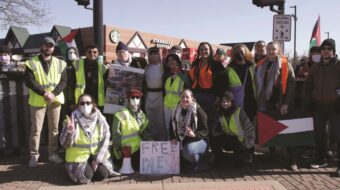LIVERMORE, Calif. – Nearly 500 community activists and members of peace and justice organizations gathered last week for two days of public hearings held by the U.S. Department of Energy on plans to greatly expand work with radioactive elements such as plutonium and tritium at Lawrence Livermore National Laboratory. The expansion is central to the Bush administration’s stepped-up program to develop new, more potent and dangerous types of nuclear weapons.
Most speakers at the sessions in Livermore and Tracy expressed grave concerns over the threats posed to the area’s environment and economy by the lab’s extensive work with radioactive elements, as well as the dangers inherent in the existence of nuclear arms.
As part of a public comment process required in updating the lab’s outdated environmental impact statement, National Nuclear Security Administration officials issued a 2,000-page report revealing plans to more than double plutonium storage limits, set up a “Modern Pit Facility” to make 450 new plutonium pits (bomb cores) annually, and boost the weapons research capacity of the National Ignition Facility’s mega-laser.
Testifying on behalf of Tri-Valley Communities Against a Radioactive Environment, Executive Director Marylia Kelley urged that all these programs be cancelled. She called for “real alternatives,” focusing on “civilian science initiatives … things that are good for us and needed in this community and the world.”
Warning of the dangers from the lab’s work that would make it easier to return to full-scale underground tests, Kelley also highlighted plans to “mix bombs and bugs” by locating an advanced bio-warfare research facility using live anthrax and other deadly pathogens at the lab.
Kelley also pointed out that the NNSA report contains no statement on how the proposed activities would impact international agreements such as the Nuclear Non Proliferation Treaty or the treaty banning biological weapons.
While most speakers were from the area most directly affected by the lab, a group of University of Washington Law School students brought the message of their organization, Greenlaw. Calling the Hanford nuclear facility the most polluted place in the Western Hemisphere, Sasha Sajovic emphasized the problems of waste management and transport. She noted that nuclear waste is now being shuffled from one facility to another through most of the 50 states, while the DOE has acknowledged there is no process for the destruction of plutonium.
Fueling the discussion was a report appearing in several area newspapers April 27 that the radioactive materials at Livermore Lab – only 44 miles from San Francisco – are considered by the U.S. Energy Department to be highly vulnerable in the event of a terrorist attack. DOE is reportedly considering removing plutonium and highly enriched uranium from the lab and other weapons sites.
The author can be reached at mbechtel@pww.org.











Comments